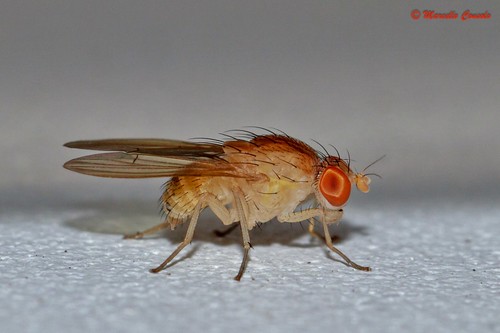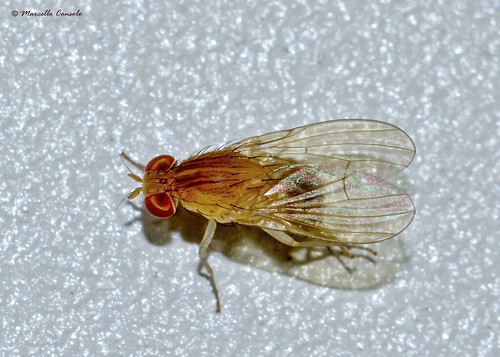Thread subject: Diptera.info :: Sapromysa sp.?
Posted by Marcello on 02-07-2013 23:12
#1
Hello,
I don't know this family, too hard to ID for me.
Is there any chance to reach the specie? I hope at least the genus is right ;)
Long about 7-8 mm, two black spots on the final abdomen, no spots/marks on the wings
01.07.2013 - Northeast Italy
 IMG_4168
IMG_4168 di
Marcello Consolo, su Flickr
I add the checklist of my Country:
Sapromyza (Sapromyza) apicalis Loew, 1847 (N)
Sapromyza (Sapromyza) bisigillata Rondani, 1868 (N)
Sapromyza (Sapromyza) intonsa Loew, 1847 (N, S)
Sapromyza (Sapromyza) obsoleta Fallén, 1820 (N, S)
Sapromyza (Sapromyza) obscuripennis Loew, 1847 (N)
Sapromyza (Sapromyza) opaca Becker, 1895 (N)
Sapromyza (Sapromyza) palpella Rondani, 1868 (N, S)
Sapromyza (Sapromyza) sexpunctata Meigen, 1826 (N, S)
Sapromyza (Sapromyza) simplicior Hendel, 1908 (N) (*)
Sapromyza (Sapromyza) tuberculosa Becker, 1895 (N)
Sapromyza (Sapromyza) trinotata O.G. Costa, 1844 (N?)
Sapromyza (Sapromyzosoma) quadricincta Becker, 1895 (N, S)
Sapromyza (Sapromyzosoma) quadripunctata (Linnaeus, 1758) (N, S)
Where N = North, S = South (I'm in North Italy)
Thanks for the help.
Ciao,
Marcello
Edited by Marcello on 02-07-2013 23:15
Posted by Mark-uk on 03-07-2013 00:09
#2
Interesting one!
It has spots on it's abdomen
and black palpi
I would rule out the follow species with spots, as they all have yellow papli
Sapromyza opaca
Sapromyza sexpunctata
Sapromyza quadricincta
Sapromyza quadripunctata
Mark
Posted by Marcello on 03-07-2013 22:57
#3
Thanks Mark, I'm reading some key's text, maybe there other two species to exclude.
But we have to add
Sapromyza albiceps Fallen 1820 wich by faunaeur is present in my country.
No spot/marks on the front, black spot on T5 and T6, by the key of Schacht et al. 2004 it could be
Sapromyza albiceps (?)
Edited by Marcello on 03-07-2013 23:32
Posted by Marcello on 04-07-2013 09:59
#4
Not
S. bisigillata, beacuse it have the spot only in T6 and the size,
S. bisigillata is at least half of this one.
Edited by Marcello on 04-07-2013 09:59
Posted by Mark-uk on 05-07-2013 22:48
#6
doesn’t not nook like any on the UK list.... do you have a key for Italian species?
Posted by Marcello on 06-07-2013 19:26
#7
I'm unable to find one with the body more large than 5mm, btw I have this:
Translation of keys of SHATALKIN, A.l. 1000
(Keys to the Palaearctic Flies of the Family Lauxaniidae (Diptera)
Zoologicheskie lssledovania 5, 102 pp., 2II figs, terminology. Moscow)
I'm asking here if someone have other keys, thanks for now, I'll advice you if I found somethings.
Ciao,
Marcello
Mark-uk wrote:
doesn’t not nook like any on the UK list.... do you have a key for Italian species?
Posted by Mark-uk on 06-07-2013 19:34
#8
The translation Shatalkin's keys are reliant on one having the Original (In Russian) for the illustrations, and for the most part male genitalia. Worth having if you have an interest in the group.
I was hoping you had a key to the Italian/Mediterranean species i was not aware of.
Posted by Marcello on 06-07-2013 22:33
#9
I have the one in Russian too for the illustration, but I think I need something more near to me.
I'm asking for the key to Italian species, but I don't know if exist some text like this.
Posted by Marcello on 06-07-2013 23:03
#10
Frontal view:

Edited by Marcello on 06-07-2013 23:03
Posted by lweit on 13-10-2015 13:19
#11
Hello
Isn'it Sapromyza albiceps (white face) ?
Louis
Posted by Mark-uk on 13-10-2015 23:50
#12
Not
Sapromyza albiceps that has white above antenna (in males), and only one orbital also (in males). but this is a female
see
http://www.dipter..._0857m.jpg Sapromyza albiceps male
Edited by Mark-uk on 13-10-2015 23:55
Posted by Paul Beuk on 14-06-2023 07:58
#13
From what I can see it still looks good for
Sapromyza bisigillata. If we take the length to inlcude thewings, it might well have been 7 mm. Black tips to the palpi, a single pair of spots on the abdomen and the smudge lines on the scutum together make it
bisigillata in my book.


